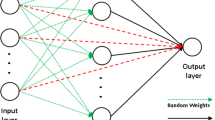Abstract
In the paper the investigation of m-out-of-n bagging with and without replacement using genetic neural networks is presented. The study was conducted with a newly developed system in Matlab to generate and test hybrid and multiple models of computational intelligence using different resampling methods. All experiments were conducted with real-world data derived from a cadastral system and registry of real estate transactions. The performance of following methods was compared: classic bagging, out-of-bag, Efron’s .632 correction, and repeated holdout. The overall result of our investigation was as follows: the bagging ensembles created using genetic neural networks revealed prediction accuracy not worse than the experts’ method employed in reality.
Access this chapter
Tax calculation will be finalised at checkout
Purchases are for personal use only
Preview
Unable to display preview. Download preview PDF.
Similar content being viewed by others
References
Biau, G., Cérou, F., Guyader, A.: On the Rate of Convergence of the Bagged Nearest Neighbor Estimate. Journal of Machine Learning Research 11, 687–712 (2010)
Borra, S., Di Ciaccio, A.: Measuring the prediction error. A comparison of cross-validation, bootstrap and covariance penalty methods. Computational Statistics & Data Analysis 12, 2976–2989 (2010)
Breiman, L.: Bagging Predictors. Machine Learning 24(2), 123–140 (1996)
Bühlmann, P., Yu, B.: Analyzing bagging. Annals of Statistics 30, 927–961 (2002)
Buja, A., Stuetzle, W.: Observations on bagging. Statistica Sinica 16, 323–352 (2006)
Czuczwara, K.: Comparative analysis of selected evolutionary algorithms for optimization of neural network architectures. Master’s Thesis (in Polish), Wrocław University of Technology, Wrocław, Poland (2010)
Efron, B., Tibshirani, R.J.: Improvements on cross-validation: the 632+ bootstrap method. Journal of the American Statistical Association 92(438), 548–560 (1997)
Friedman, J.H., Hall, P.: On bagging and nonlinear estimation. Journal of Statistical Planning and Inference 137(3), 669–683 (2007)
Fumera, G., Roli, F., Serrau, A.: A theoretical analysis of bagging as a linear combination of classifiers. IEEE Transactions on Pattern Analysis and Machine Intelligence 30(7), 1293–1299 (2008)
Góral, M.: Comparative analysis of selected evolutionary algorithms for optimization of fuzzy models for real estate appraisals. Master’s Thesis (in Polish), Wrocław University of Technology, Wrocław, Poland (2010)
Graczyk, M., Lasota, T., Trawiński, B.: Comparative Analysis of Premises Valuation Models Using KEEL, RapidMiner, and WEKA. In: Nguyen, N.T., Kowalczyk, R., Chen, S.-M. (eds.) ICCCI 2009. LNCS, vol. 5796, pp. 800–812. Springer, Heidelberg (2009)
Graczyk, M., Lasota, T., Trawiński, B., Trawiński, K.: Comparison of Bagging, Boosting and Stacking Ensembles Applied to Real Estate Appraisal. In: Nguyen, N.T., Le, M.T., Świątek, J. (eds.) Intelligent Information and Database Systems. LNCS (LNAI), vol. 5991, pp. 340–350. Springer, Heidelberg (2010)
Kim, D., Kim, H., Chung, D.: A Modified Genetic Algorithm for Fast Training Neural Networks. In: Wang, J., Liao, X.-F., Yi, Z. (eds.) ISNN 2005. LNCS, vol. 3496, pp. 660–665. Springer, Heidelberg (2005)
Kontrimas, V., Verikas, A.: The mass appraisal of the real estate by computational intelligence. Applied Soft Computing 11(1), 443–448 (2011)
Król, D., Lasota, T., Trawiński, B., Trawiński, K.: Investigation of Evolutionary Optimization Methods of TSK Fuzzy Model for Real Estate Appraisal. International Journal of Hybrid Intelligent Systems 5(3), 111–128 (2008)
Krzystanek, M., Lasota, T., Telec, Z., Trawiński, B.: Analysis of Bagging Ensembles of Fuzzy Models for Premises Valuation. In: Nguyen, N.T., Le, M.T., Świątek, J. (eds.) Intelligent Information and Database Systems. LNCS (LNAI), vol. 5991, pp. 330–339. Springer, Heidelberg (2010)
Lasota, T., Mazurkiewicz, J., Trawiński, B., Trawiński, K.: Comparison of Data Driven Models for the Validation of Residential Premises using KEEL. International Journal of Hybrid Intelligent Systems 7(1), 3–16 (2010)
Lasota, T., Telec, Z., Trawiński, B., Trawiński, K.: Exploration of Bagging Ensembles Comprising Genetic Fuzzy Models to Assist with Real Estate Appraisals. In: Corchado, E., Yin, H. (eds.) IDEAL 2009. LNCS, vol. 5788, pp. 554–561. Springer, Heidelberg (2009)
Lewis, O.M., Ware, J.A., Jenkins, D.: A novel neural network technique for the valuation of residential property. Neural Computing & Applications 5(4), 224–229 (1997)
Molinaro, A.N., Simon, R., Pfeiffer, R.M.: Prediction error estimation: A comparison of resampling methods. Bioinformatics 21(15), 3301–3307 (2005)
Peterson, S., Flangan, A.B.: Neural Network Hedonic Pricing Models in Mass Real Estate Appraisal. Journal of Real Estate Research 31(2), 147–164 (2009)
Polikar, R.: Ensemble Learning. Scholarpedia 4(1), 2776 (2009)
Schapire, R.E.: The Strength of Weak Learnability. Mach. Learning 5(2), 197–227 (1990)
Worzala, E., Lenk, M., Silva, A.: An Exploration of Neural Networks and Its Application to Real Estate Valuation. Journal of Real Estate Research 10(2), 185–201 (1995)
Yao, X.: Evolving artificial neural networks. Proceedings of the IEEE 87(9), 1423–1444 (1999)
Author information
Authors and Affiliations
Editor information
Editors and Affiliations
Rights and permissions
Copyright information
© 2011 Springer-Verlag Berlin Heidelberg
About this paper
Cite this paper
Lasota, T., Telec, Z., Trawiński, G., Trawiński, B. (2011). Empirical Comparison of Resampling Methods Using Genetic Neural Networks for a Regression Problem. In: Corchado, E., Kurzyński, M., Woźniak, M. (eds) Hybrid Artificial Intelligent Systems. HAIS 2011. Lecture Notes in Computer Science(), vol 6679. Springer, Berlin, Heidelberg. https://doi.org/10.1007/978-3-642-21222-2_26
Download citation
DOI: https://doi.org/10.1007/978-3-642-21222-2_26
Publisher Name: Springer, Berlin, Heidelberg
Print ISBN: 978-3-642-21221-5
Online ISBN: 978-3-642-21222-2
eBook Packages: Computer ScienceComputer Science (R0)




